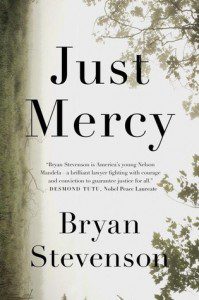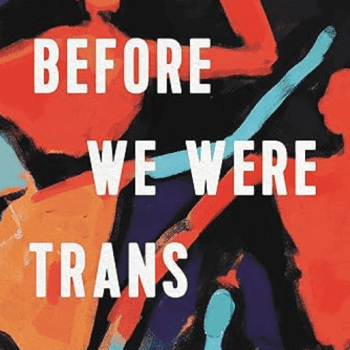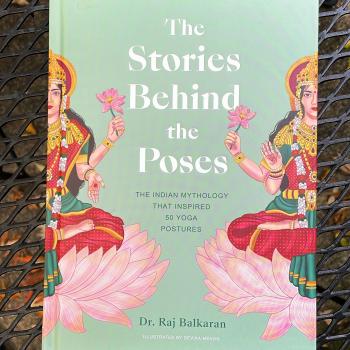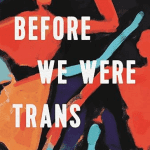Each year the Unitarian Universalist Association selects one book as a “Common Read” that all UUs are encouraged to study, discuss, and respond to. Previous Common Reads have included:
- The Death of Josseline: Immigration Stories from the Arizona-Mexico Borderlands
- Acts of Faith: The Story of an American Muslim, the Struggle for the Soul of a Generation
- The New Jim Crow: Mass Incarceration in the Age of Colorblindness,
- Behind the Kitchen Door (justice for restaurant workers)
- Reclaiming Prophetic Witness: Liberal Religion in the Public Square
If any of those titles pique your interest, I recommend any or all of them.
 This year’s UUA Common Read is the memoir Just Mercy by Bryan Stevenson, an attorney, human rights activist, and founder of the Equal Justice Initiative. He is one of the most acclaimed and respected lawyers in the nation, a recipient of the MacArthur Foundation “Genius” Grant, and a tenured law professor at New York University School of Law.
This year’s UUA Common Read is the memoir Just Mercy by Bryan Stevenson, an attorney, human rights activist, and founder of the Equal Justice Initiative. He is one of the most acclaimed and respected lawyers in the nation, a recipient of the MacArthur Foundation “Genius” Grant, and a tenured law professor at New York University School of Law.
The epigraph at the beginning of his book Just Mercy quotes theologian Reinhold Niebuhr: “Love is the motive, but justice is the instrument.” I understand that quote to mean that love alone is necessary, but not sufficient, to reach our goals. We must harness the power of love in the work of justice. Or in the words of philosopher Cornel West, “Justice is what love looks like in public, just like tenderness is what love feels like in private.” What, then, for Stevenson, is the injustice against which we must harness the power of love and mercy? Consider a few statistics:
- We the people of The United States of America “have the highest rate of incarceration in the world. [Our] prison population has increased from 300,000 people in the early 1970s to 2.3 million people today” (Stevenson 15).
- “In the United States, the number of women sent to prison increased 646 percent between 1980 and 2010” (233).
- As a result of these trends, “Spending on jails and prisons by state and federal governments has risen from $6.9 billion in 1980 to nearly $80 billion today,” creating a profit motive to imprison increasing numbers of people (16).
- A racial disparity is woven into this Prison-Industrial Complex. People of color, especially African-Americans, are arrested, convicted, and given the death penalty at far higher rates that white Americans (142).
Among the many powerful stories Stevenson tells about in seeking to reverse these trends, one of the most moving is his work to free Anthony Ray Hinton. In the year 2000, DNA evidence confirmed his innocence, but prosecutors refused to reconsider the case until the United States Supreme Court ordered them to in 2015. After serving almost 30 years on Alabama’s death row, “Mr. Hinton became the 152nd person in American exonerated and proved innocent after having been wrongly convicted and sentence to death” (315).
Looking back, my own awakening around the brokenness of our criminal justice system, particularly in regard to the death penalty, began with the 1995 film Dead Man Walking. At the center of the movie is the story of a Roman Catholic nun (played by Susan Sarandon) serving as a spiritual adviser for a death row inmate (played by Sean Penn). The portrayal oscillates between uncovering the humanity at the heart of Penn’s character (Matthew Poncelet) and reminding the audience about the horror of his crime. Each time your heart begins to break in compassion for this prisoner and his family, you are reminded of the demand for justice for his victims and their family.
When I first saw the film, it was part of an undergraduate class on Religion and Ethics. Reflecting on the film in that context and coming from a Christian background, it was particularly striking to me to consider anew that Jesus also had been killed by the death penalty — and that the cross, like the contemporary electric chair, was a symbol of state execution. Consider the parallels: if Jesus had died during the French Revolution, would we see people wearing gold-plated guillotines? Or if Jesus had died in the U.S., would we see gold-plated hypodermic needles (for lethal injection) or gold-plated electric chairs used decoratively at the tops of steeples, or as jewelry?
As is depicted so powerfully in that film, I want to keep the tension in front of us between the UU First Principle (“The inherent worth and dignity of every person”) and the horrific acts that are committed by our fellow human beings—and demand consequences. Regarding the first side of that tension (“The inherent worth and dignity of every person”), Bryan Stevenson writes the following about the lessons he has learned from decades of working with death row inmates:
Proximity has taught me some basic and humbling truths, including this vital lesson: Each of us is more than the worst thing we’ve ever done. My work with the poor and the incarcerated has persuaded me that the opposite of poverty is not wealth; the opposite of poverty is justice. Finally, I’ve come to believe that the true measure of our commitment to the rule of law, fairness, and equality cannot be measured by how we treat the rich, the powerful, the privileged, and the respected among us. The true measure of our character is how we treat the poor, the disfavored, the accused, the incarcerated, and the condemned…. We all need mercy, we all need justice, and—perhaps—we all need some measure of unmerited grace (18).
Stevenson’s motive for founding his Equal Justice Initiative is that our criminal justice system does not treat all people the same. Rather, in the words of one of his mentors, the truth about capital punishment in our country is that, “them without the capital get the punishment” (6).
So how might we better achieve what Stevenson calls “Just Mercy” in a way that honors the call for both justice and mercy? How do we honor the “inherent worth and dignity of every person,” while also enforcing consequences for transgressions, both minor and major, against people and property? The most hopeful paradigm shift that I have found is the move from our current system of punitive justice or retributive justice to a system called restorative justice.
Along these lines, around the same time that I first saw the film Dead Man Walking, I learned about a group called Murder Victims’ Families for Reconciliation. Through this organization, I learned about the experience of many families who have experienced the death penalty as a false hope. After years of waiting through expensive appeals that focused much more on the perpetrator than the victims, the actual day of execution did not bring the closure they anticipated. Once the murderer was executed, they discovered that underneath their anger was unresolved grief. What they really wanted could not be realized through more death. What they really wanted was their loved one back.
Some theologians call this dynamic the “Myth of Redemptive Violence”: the idea that the best way to respond to violence is with more violence. But even the retributive justice of an “eye for an eye” or a “life for a life” most often—either intentionally or unintentionally—sows the seeds of further violence. In the words of The Rev. Dr. Martin Luther King, Jr., “The ultimate weakness of violence is that it is a descending spiral, begetting the very thing it seeks to destroy. Instead of diminishing evil, it multiplies it…. Returning violence for violence multiplies violence, adding deeper darkness to a night already devoid of stars. Darkness cannot drive out hate; only love can do that.”
Within our current criminal justice system, a crime means that a law has been broken and the offended party is the state. In this retributive system, justice means determining the amount of punishment the offender deserves. Often the victims and offenders are for the most part observers of a process administered by a court system and navigated by professional attorneys. In contrast, as Howard Zehr has written in his helpful guide The Little Book of Restorative Justice, in a Restorative Justice system, the infraction is not breaking a law, but “a violation of people and relationship,” and the central focus is the victim’s needs and the offender’s “responsibility for repairing harm” (21).
One of the primary shadow sides of our current retributive justice system is that the emphasis on “making things unpleasant for offenders” has the unintended consequence of “encouraging offenders to focus on their own plight, rather than that of their victims.” In contrast, a restorative justice process has a “strong emphasis on shocking offenders into awareness of the harm they have caused…by having victims tell them personally about how the crime has affected them” (Johnstone 99). Perhaps the most well-known example of this approach is the Truth and Reconciliation Commission in South Africa in the wake of racial apartheid.
Let me give you two more examples: one easier, the other harder. First, school systems are increasingly finding success with restorative justice. When a student misbehaves, a retributive paradigm requires that a student be punished — which often involves removing the students from the classes through detention, suspension, and expulsion. However, such punishments risk both alienating and isolating the student (who was likely acting out in the first place because she was feeling alienated or isolated) as well as putting the student further behind academically. Moreover, as with the criminal justice system, students of color are punished more frequently and more harshly in schools than white students. In contrast, restorative justice processes model conflict resolution for troubled students tools and increase social-emotional skills through facilitated dialogued between everyone involved in the conflict. There are still consequences, but the consequences are intended to bring restitution and reconciliation.
Here’s a more difficult example drawn from an article in The Atlantic. Norway is one of a number of countries that have restorative justice practices integrated into their justice systems. Many of you will recall that in 2011, a right-wing extremist named Anders Breivik killed 77 people. For these terrorist attacks he was sentenced to 21 years in prison: “That’s just under 100 days per murder.” However, he will likely be in prison for the rest of his life because the sentence can be extended. Of interest, media interviews with the victims’ families showed “relief and satisfaction with the verdict.”
In this case, the Restorative Justice approach took into account not only punishing the perpetrator, but also the needs of the victims:
In the Breivik trial, this meant giving every victim (survivors as well as the families of those killed) a direct voice.… The court heard 77 autopsy reports, 77 descriptions of how Breivik had killed them, and 77 minute-long biographies “voicing his or her unfulfilled ambitions and dreams….” The trial itself is about more than just proving or disproving guilt, but about exorcising the victims’ suffering.
In many instances, this process also leads to inner transformation and emotional breakthroughs for the offenders, thereby lowing recidivism rates, but Breivik was “a remorseless, fist-pumping neo-Nazi to the very end,” which is why his sentence will likely be extended through the rest of his life.
In Norway and other countries, restorative justice practices also extend to imprisonment:
A comfortable cell, a clean and relaxing environment, and nice daily activities such as cooking classes are all meant to prepare the criminal for potentially difficult or painful internal reformation. Incarceration, in this thinking, is the treatment for whatever social or psychological disease led them to transgress. The criminals are not primarily wrongdoers to be punished, but broken people to be fixed.
This approach is one attempt at what Bryan Stevenson calls “just mercy,” which seeks to honor the “inherent worth and dignity of every person,” while also enforcing consequences for transgressions.
Restorative Justice is an example of a movement that call us to our best selves and challenges us to build a world that offers peace, liberty, and justice not merely for some, but for all. In that spirit, I invite you to consider once more those words quoted earlier from Bryan Stevenson about the lessons he has learned from working directly with death row inmates for many years:
Proximity has taught me some basic and humbling truths, including this vital lesson: Each of us is more than the worst thing we’ve ever done. My work with the poor and the incarcerated has persuaded me that the opposite of poverty is not wealth; the opposite of poverty is justice. Finally, I’ve come to believe that the true measure of our commitment to the rule of law, fairness, and equality cannot be measured by how we treat the rich, the powerful, the privileged, and the respected among us. The true measure of our character is how we treat the poor, the disfavored, the accused, the incarcerated, and the condemned…. We all need mercy, we all need justice, and—perhaps—we all need some measure of unmerited grace.
The Rev. Dr. Carl Gregg is a trained spiritual director, a D.Min. graduate of San Francisco Theological Seminary, and the minister of the Unitarian Universalist Congregation of Frederick, Maryland. Follow him on Facebook (facebook.com/carlgregg) and Twitter (@carlgregg).
Learn more about Unitarian Universalism: http://www.uua.org/beliefs/principles
















